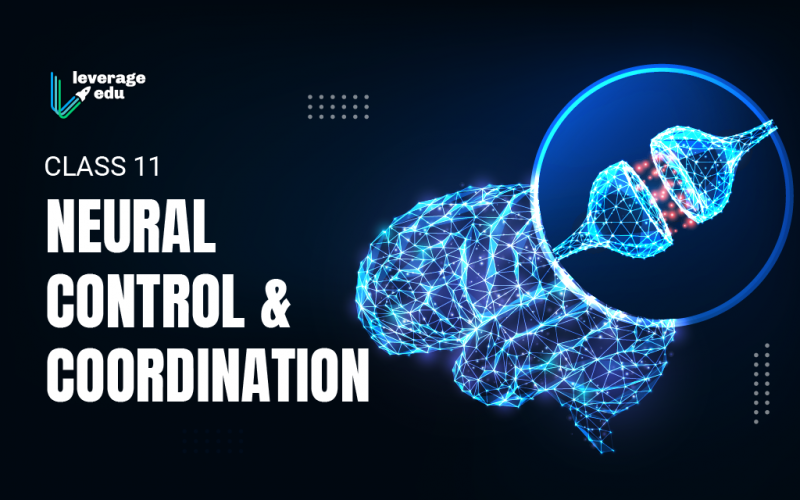Biology is one of the most popular subjects of science streams globally, being the study of the human body. Like many natural processes that occur around us, our bodies too maintain coordination to maintain homeostasis. Control and coordination are vital processes through which organs complement each other’s functions and interact with one another. For example, whenever we are too close to a fire, the nervous system acts and sends the message to the brain, the brain then signals us to take a step back, and hence we move farther from the fire. This example shows the mechanisms of the neural system and endocrine (hormonal) system and their coordination. In this chapter for Class 11 Neural Control and Coordination, you will understand the neural system of humans and mechanisms of neural coordination, which is an important part of the CBSE class 11 biology syllabus.
Table of contents
Human Neural System
All animals are created with specialized cells called neurons. It is studied in the many branches of biology. These neurons can detect, receive and transmit different kinds of stimuli. Let’s look at the human neural system in this chapter Class 11 Neural Control and Coordination.
The Human Neural System is divided into two sections:
- The Central Neural System (CNS): The CNS comprises the nerves of the brain and spinal cord which is the main area for incoming information and control.
- The Peripheral Neural System (PNS): The PNS has nerve fibers of two types i.e. afferent fibers and efferent fibers.
Impulses are transmitted by the afferent nerve fibers from tissues or organs to the CNS. The efferent fibers transmit regulatory impulses from the CNS to the specific peripheral tissues or organs.
The PNS is divided into two divisions which are:
- Somatic Neural System
- Autonomic Neural System
The somatic neural system relays impulses from the CNS to skeletal muscles. In contrast, the autonomic neural system transmits impulses from the CNS to the body’s involuntary organs and smooth muscles.
The autonomic neural system is further divided into the sympathetic neural system and parasympathetic neural system.
The Neuron
A neuron is the basic unit of the brain which is specialized to transmit information to and from muscles, gland cells, and nerve cells. Let’s view the basic structure of a neuron for class 11 neural control and coordination. A neuron is a microscopic structure that comprises three major parts:
- Cell Body (soma): The cell body is where the nucleus and the neuron’s DNA lies. It contains cytoplasm with typical cell organelles and granular bodies called Nissl’s granules
- Dendrites: The dendrites are short fibres that branch repeatedly and project out of the cell body.
- Axon: The axon is a long fibre with a distal branched end. It is the is output structure of the neuron.

Action Potential: The information (electrical charge) received travels from the dendrites through the cell body and down the axon. The electrical impulse (known as an action potential) proceeds down the axon by a continuous series of openings and closings of the sodium-potassium channels. Chemicals called neurotransmitters move the information across the synapse which bind to their specific receptors. A synapse is a gap between the axon of one neuron (presynaptic neuron) and another neuron’s dendrite ( post-synaptic neuron). The synapse has two types, i.e. electrical synapses and chemical synapses.
Central Neural System
The next topic for Class 11 Neural Control and Coordination is the Central Neural System. The central neural system mainly comprises the brain and the spinal cord.
- The brain is the central information processing organ of our body where the processing of vision, memory, intelligence, emotions, hearing, speech, and thoughts occur.
- It looks over and controls all the voluntary movements, the balance of the body, thermoregulation, hunger and thirst, functioning of vital involuntary organs ( lungs, heart, kidneys, etc.), circadian (24-hour) rhythms of our body, activities of several endocrine glands and human behaviour.
- The skull protects the human brain. The brain is covered by cranial meninges consisting of an outer layer called the dura mater, a skinny middle layer called arachnoid, and an inner layer (which is in contact with the brain tissue) pia mater.
- The brain is divided into three major parts: The Forebrain, The Midbrain, and The Hindbrain.

These were all the major subtopics for Class 11 Neural Control and Coordination notes. We hope it helps you in preparing for your exam. If you need guidance related to your career, feel free to contact our experts at Leverage Edu! Sign up for a free session today!
-
it is possible to send me this chapters notes.

 One app for all your study abroad needs
One app for all your study abroad needs






















 45,000+ students trusted us with their dreams. Take the first step today!
45,000+ students trusted us with their dreams. Take the first step today!



1 comment
it is possible to send me this chapters notes.